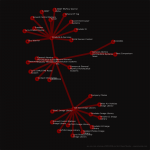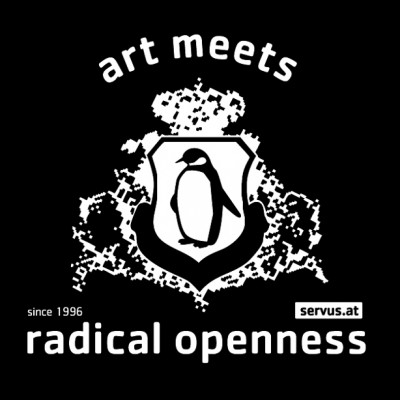I’ve just returned from Linz, Austria, where I attended the art and technology festival/conference/exhibition called Art Meets Radical Openness (LiWoLi 2011). It is put on and hosted by Ushi Reiter and others of servus.at, and Martin Kaltenbrunner (creator of Reactable) and others at the Kunst Universität Linz.
While I was here I met a lot of friendly and engaging people, and saw some great works, talks, and performances. I also gave a paper about Give Me My Data, titled, “The Self-Indulgence of Closed Systems.” The presentation was about my current research into historic and contemporary modes of surveillance, ensuing privacy issues, and examples of resistance to these modes of data gathering. It was part the Naked on Pluto lecture series, organized by the cheery Marloes de Valk.
I also conducted a 2-day workshop, “Freedom for Our Files: Creative Reuse of Personal Data,” where I shared information and examples on how to go about data scraping and spidering, reuse and visualization, and using the Facebook API for all of the same, for creative or experimental purposes. I’ve posted some of the code and content from FFOF already.
One important motivation for my attendance was to meet programmers who might be interested in working with me on the more technical aspects of upgrading Give Me My Data to the new Facebook Graph API and finding a way around undocumented data limits imposed by Facebook that my users continue encountering.
Give Me My Data: A Short History
I thought I would give a little bit of a background here, about Give Me My Data, for those interested in its development and other related projects.
 In 2008 I finished my Masters of Fine Arts at the University of California, San Diego with a thesis project titled Camp La Jolla Military Park. It was a fictional national park which documented the history and ongoing collaboration between the university with the defense industry. I created a custom content management system (PHP, MySQL, Google Maps API) and formed a group of collaborators to enter data in the system documenting relationships. The project exists now as a series of brochures and website which mimics the national park website and describes the research we conducted. I also gave tours of the “park” (campus) where technology was being developed for defense contractors and other sites with related interest.
In 2008 I finished my Masters of Fine Arts at the University of California, San Diego with a thesis project titled Camp La Jolla Military Park. It was a fictional national park which documented the history and ongoing collaboration between the university with the defense industry. I created a custom content management system (PHP, MySQL, Google Maps API) and formed a group of collaborators to enter data in the system documenting relationships. The project exists now as a series of brochures and website which mimics the national park website and describes the research we conducted. I also gave tours of the “park” (campus) where technology was being developed for defense contractors and other sites with related interest.
The following year, while working during my first year as an assistant professor at Florida State University, I described and began developing aspects of a project I temporarily titled Automata. The project, which was a finalist in 2009 for the Rhizome Commission, proposed to use technology to visualize relationships in which there might exist ethical contradictions, but are difficult to discern for all the actors involved. An example of an ethical contradiction might be collaborations between the defense industry and educational institutions which encourage students to develop technology used to harm other human beings. I proposed to do this through various automated web spiders, semantic analysis, and finally visualizations and other interfaces to the data.
While working on Automata, which was named to reference the automation of the documentation Camp La Jolla performed, I was invited to MIT by Chris Csikszentmihályi, Research Scientist at the MediaLab and Director of Center for Future Civic Media at MIT, to discuss the project with members of his Center for Future Civic Media.
Later in 2009, while planning how I might visualize the network data from Automata, rather than creating the content from scratch I decided to use my Facebook contacts as a test subject. Since there was no application which exported data in various reusable formats, especially one which arranged the contacts into a format which described relationships, I created my own.
 This application, live since October 2009, would soon became very popular in its own right. In late April 2010, Facebook made a change to the way they allowed users to present information about themselves. Previously entered user data was suddenly aggregated without permission in order to encourage strangers with common interests to form groups. This slight change in policy caused an uproar within the Facebook community because it attempted to force people together without regard to individual privacy.
This application, live since October 2009, would soon became very popular in its own right. In late April 2010, Facebook made a change to the way they allowed users to present information about themselves. Previously entered user data was suddenly aggregated without permission in order to encourage strangers with common interests to form groups. This slight change in policy caused an uproar within the Facebook community because it attempted to force people together without regard to individual privacy.
Many Facebook users were originally attracted to the site because of its levels of privacy and therefore found this change to be manipulative and deeply disturbing. Further, users were no longer able to access or change this information because it had been incorporated into a larger structure. In their article, Facebook App Brings Back Data, May 1, 2010, The New York Times documented how my application allowed users to regain access to this and other information hidden behind the Facebook interface.
At this time, Facebook (still) did not feature a method to export your data for any purpose. In November 2010, likely influenced by Give Me My Data, Facebook finally added a way for users to export their profile data as a series of HTML pages. I believe their motivation originates in part with my application, and points to the effectiveness of such forms of public art / creative resistance to reach out beyond the art world and contribute to society in lasting ways.
What Now?
 So in conclusion, I created Give Me My Data while working on projects related in concept and execution. While I have paused my work on Automata you can see some sitemap visualizations from the project in a series called Firing Blind.
So in conclusion, I created Give Me My Data while working on projects related in concept and execution. While I have paused my work on Automata you can see some sitemap visualizations from the project in a series called Firing Blind.
As for the status of Give Me My Data, I developed it using the Facebook REST API, which will be deprecated soon. It uses both REST and FQL (Facebook Query Language) calls to help users access a variety of types and formats of their data. I’m working now to put the project on Github, thereby making the code open source, and also to invite others to help to upgrade the data retrieval method to the Facebook Graph API, and to improve existing code that reformats the data from JSON to XML, CSV, GraphML, Dot, and other popular data formats. Now that I have a handful of business cards and new acquaintances I’m looking forward to moving forward. Please get in touch if you are interested in contributing.

Hi,
How far are you in terms of making the code for this application available via GitHub?
Here you go https://github.com/omundy/fb_canvas_starter_app